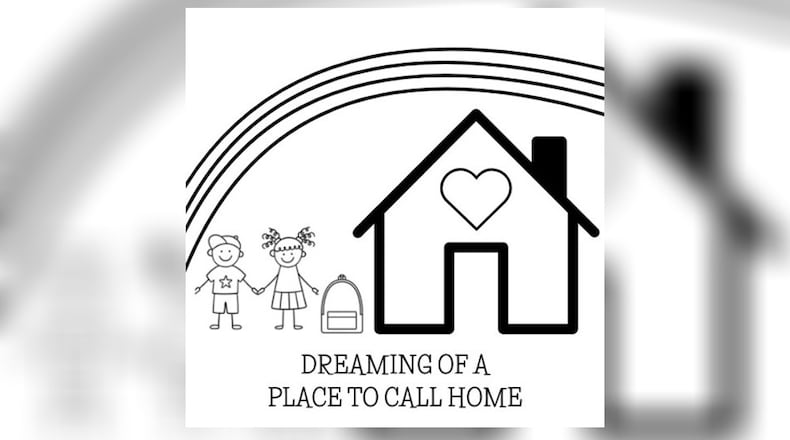This multi-sensory exhibit, which is appropriate for all ages, spotlights the struggles faced by families with children experiencing homelessness in the Miami Valley, the state of Ohio, and the country overall.
“There are a lot of reasons why kids are homeless or unhoused but this exhibit brings attention to the issues of eviction and affordable housing,” said Katherine Rowell, a professor of sociology at Sinclair Community College who conceived and is spearheading the exhibit. “Kids have a voice. And part of the exhibit is children’s art and their dreams of home. Even though kids might be living in a shelter and may have lost their housing, like every single American they have dreams of home. All of their paintings and drawings are part of the exhibit.”
Rowell also believes the quest for peace aligns with economics, which is essential to understanding the challenges associated with homelessness.
“You can’t have peace without economic justice,” she said. “When people are struggling and they have the insecurity of a home, you can’t have internal peace or community peace. Neighborhoods that have high eviction rates with lots of turnover also have higher rates of violence because there are people who are not living in stable conditions. Experiencing eviction and homelessness is at the same level as other traumas, which makes it really hard for kids to go on and have normal lives. I have students that have experienced eviction as children and it sticks with you.”
Credit: CONTRIBUTED
Credit: CONTRIBUTED
Alice Young-Basora, the museum’s executive director, is also concerned about the unhoused, particularly the evolution of how homelessness is defined today.
“In Ohio, I think between 980 to 1,000 kids are going without a home every single day, which is horrible,” Young-Basora said. “And homelessness does not look like what people stereotype it to look like. Often, for kids, homelessness looks like sleeping on a couch or sleeping in their cousin’s room or sleeping where it it’s convenient. Often it looks like sleeping on a cot in a homeless shelter but those are not ideal places for kids. And moms typically are the ones who take their kids to homeless shelters. So, they will go any other place they can that is safe and warm and available. Backpacks are also a symbol of (this crisis) as a child is often told they have to put everything they care about in their world in a backpack before they have to leave their home.”
In addition a documentary about children through the lens of eviction and homelessness in the Dayton community, tentatively scheduled to screen in Dayton in January, serves as a companion piece to the exhibit. Clips of the documentary, which features 17 children, will be on display.
“People will be able to hear what kids have to say to grown-ups about how to fix the problem and what kids have to say about their dreams and their future,” Rowell said. “Experiencing eviction makes it hard for children to develop healthy attachments. The kids discuss how they lost everything, including their toys. They learn not to get attached to anything.”
A study released last fall by researchers with Princeton University, Rutgers University and the U.S. Census Bureau found that about 2.9 million children each year are affected by eviction filings.
“We demonstrate not only that the average evicted household includes one child, but that the most common age to experience eviction in America is during childhood,” the study says.
“I hope people realize this (subject) is a lot more prevalent than they realize,” Young-Basora said. “And there are a lot of things we can do as a collective community to change it. I hope this (exhibit) inspires them to make some changes as a community and support those changes while coming to learn and dream of ways we can make a difference and have hope.”
Students from Sinclair Community College, University of Dayton and Wittenberg University helped collaborate on this project, which is part of an American Council of Learned Societies Fellowship Rowell received three years ago to research stories of children experiencing homelessness in the community. A curriculum guide, an empathy room, and two listening stations are also part of the exhibit, which addresses educational issues like absenteeism and societal concerns like racial disparity.
“In Matthew Desmond’s book, ‘Evicted,’ he says Black men are locked up and Black women are locked out,” Rowell said. “It’s so sad to think people are being evicted with children. Peace isn’t just the absence of violence. It’s the ability to lead a flourishing life.”
HOW TO GO
What: “Dreaming Of a Place To Call Home: Children and Housing Insecurity in America”
When: Nov. 22, 2024-Feb. 1, 2025. Monday-Thursday by appointment only, and Fridays and Saturdays from 10 a.m.-5 p.m.
In addition an opening reception will take place from 12:30-2:30 p.m. Saturday, Nov. 23. Rowell and some of the children involved in the documentary will be in attendance.
Where: International Peace Museum, 10 N. Ludlow St., Dayton
More info: 937-227-3223 or https://peace.museum
FYI: The museum will be collecting donations of new children’s backpacks during exhibit hours to donate to Hannah’s Treasure Chest. Also, Rowell is available to give tours of the exhibit. Contact the museum for more information.
Cornelius Frolik contributed to this article.
About the Author




